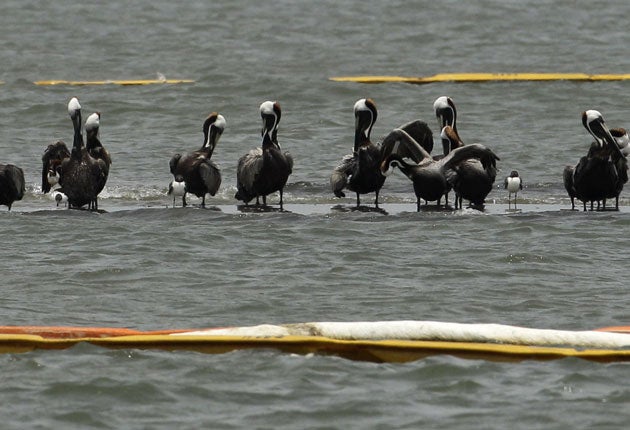Obama shames bosses over oil spill blame game

President Barack Obama yesterday criticised BP and other oil companies for blaming each other instead of accepting responsibility for the environmental catastrophe caused by the huge oil spill in the Gulf of Mexico.
Mr Obama accused BP and others involved in operating the rig and drilling the well of presenting a "ridiculous spectacle" as they accused each other during congressional hearings investigating the causes behind the blast. There's "enough blame to go around and all parties should be willing to accept it", the President said.
As he spoke yesterday at the White House, BP was using deep-sea robots in its latest attempt to close off the leak in the Gulf of Mexico by threading a tube into the fractured pipe pouring crude oil into the ocean, amid claims that the size of the vast spill has been grossly underestimated.
American authorities, who engaged in a frantic operation with the British oil giant involving 5,000 vessels and millions of miles of plastic booms to try to contain the leak on the surface, believe the spill now covers an area of about 3,650 square miles of ocean. The slick has broken into smaller parts, and, while potentially catastrophic, may no longer threaten to reach land in huge amounts, the US coastguard commandant Admiral Thad Allen said.
But scientists and environmentalists are increasingly questioning whether the volume of the leak is far greater than previous official estimates. The leak began on 20 April when the Deepwater Horizon rig sub-contracted by BP to pump oil from the Gulf of Mexico exploded, killing 11 workers. The US government has stuck by its estimate that 5,000 barrels – or 210,000 gallons – a day of crude is flowing from the broken pipe.
Critics say that estimate is based on an inappropriate scientific technique and, according to one eminent oceanographer, the rate of the spill could be at least four or five times the official figure.
Ian MacDonald, a scientist at Florida State University and an expert in analysing oil slicks, said satellite imagery showed the spill was much larger than the official projections and accurate figures were required to help calculate the amount of damage the slick – which threaten the coast of four US states – could cause. Dr MacDonald told The New York Times: "The government has a responsibility to get good numbers."
BP has repeatedly stated that it is impossible accurately to measure the rate of the leak and such a figure would make no material difference to its efforts to try to halt and clean up the spill. In the immediate days after the explosion on the Deepwater Horizon, owned and operated by the American company Transocean, BP claimed the flow from the broken well was about 1,000 barrels a day.
In later testimony to Congress, the British company said that, in the worst-case scenario – if the leak increased – the flow could be as much as 60,000 barrels a day, equivalent to a spill the size of the Exxon Valdez disaster every four days.
Mr Obama said he shared the "anger and frustration" felt by many Americans, and he acknowledged there were differing estimates over how much oil was leaking. The President also pledged to end a "cosy relationship" between the oil industry and federal regulators that, he said, had existed for years.
Tony Hayward, BP's chief executive, who is seeing the bill for dealing with the slick increase by more than £6m a day, admitted this week that the disaster could cost him his job. He has said he will stay in America until BP manages to contain the leak.
BP, which has so far spent more than £300m trying to contain the leak that has poured more than 15 million litres of oil into the sea in the past three weeks, is hoping that inserting a 15cm-wide tube into the jagged 53cm-wide conduit responsible for the worst of the spill will finally staunch the flow.
Rather like a rubber bung and spout inserted into a bottle, the smaller tube will be surrounded by a plastic stopper to stop oil from leaking around the main pipe. It is hoped the tube, which could be in place as early as today if the operation is successful, will then be used to siphon the oil to a tanker on the surface.
The new technique is the latest method being deployed by BP to try to end the leak. A previous effort, using a heavy steel funnel to try to cover the split pipe, failed after chemicals escaping from the leak froze and blocked the device at a depth of 5,000ft.
Join our commenting forum
Join thought-provoking conversations, follow other Independent readers and see their replies
Comments
Bookmark popover
Removed from bookmarks